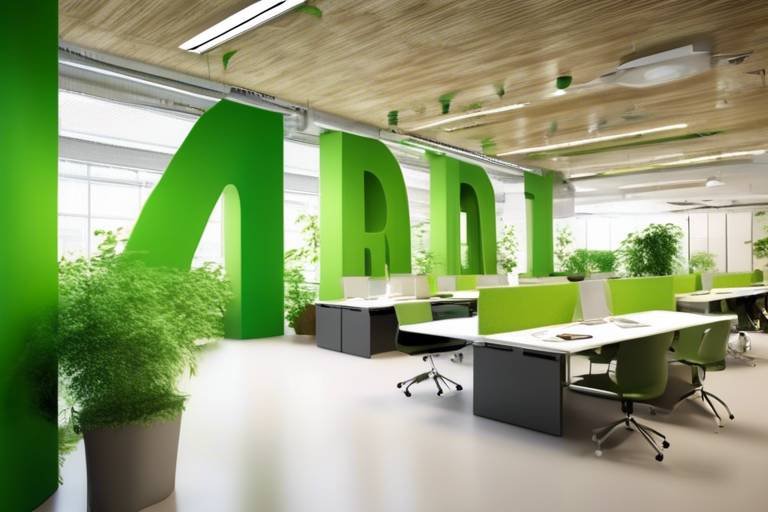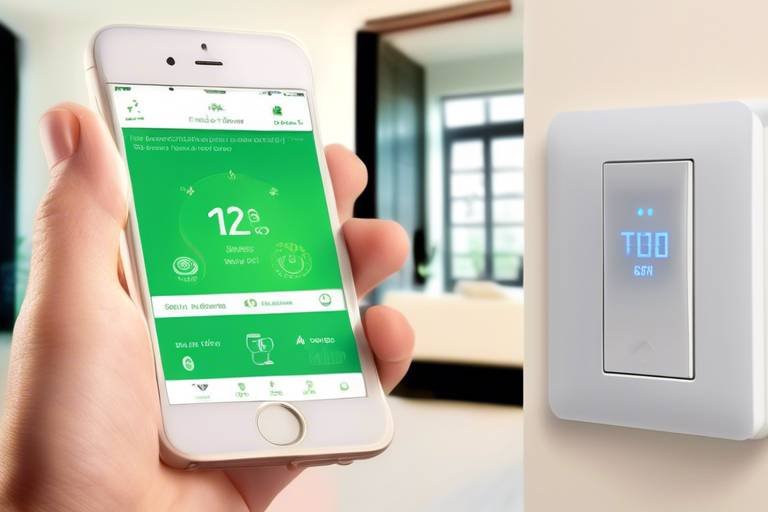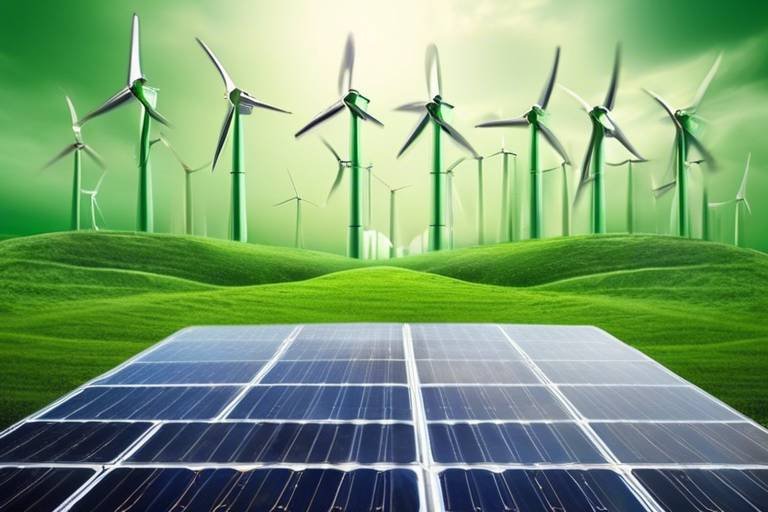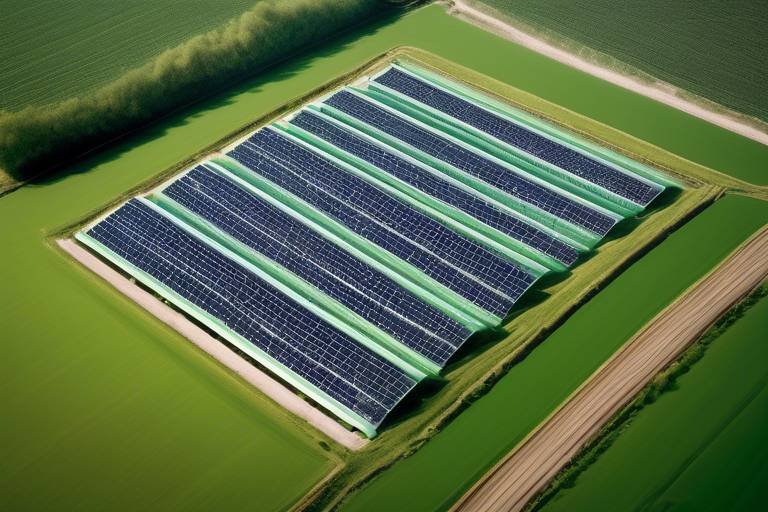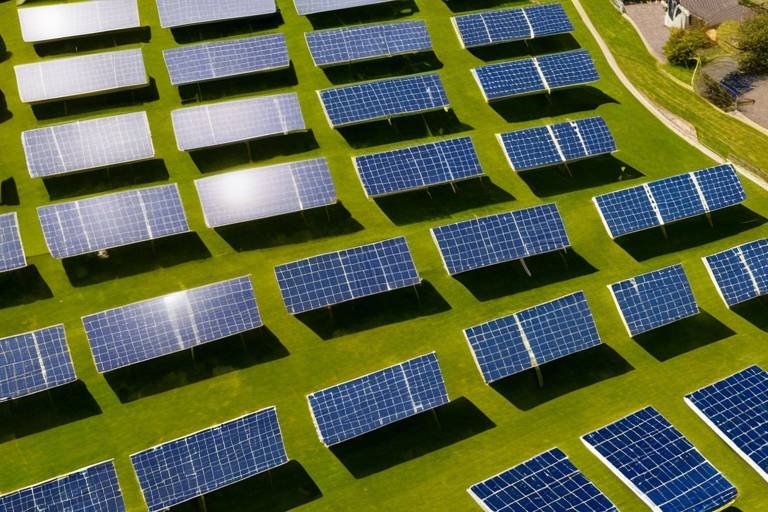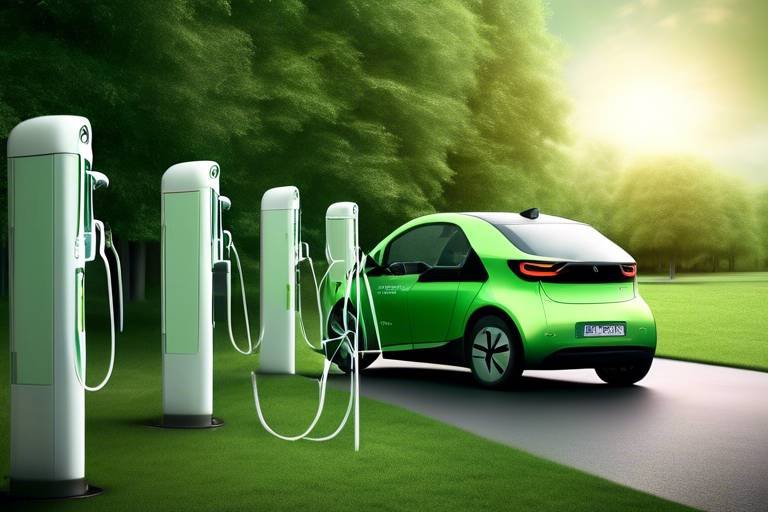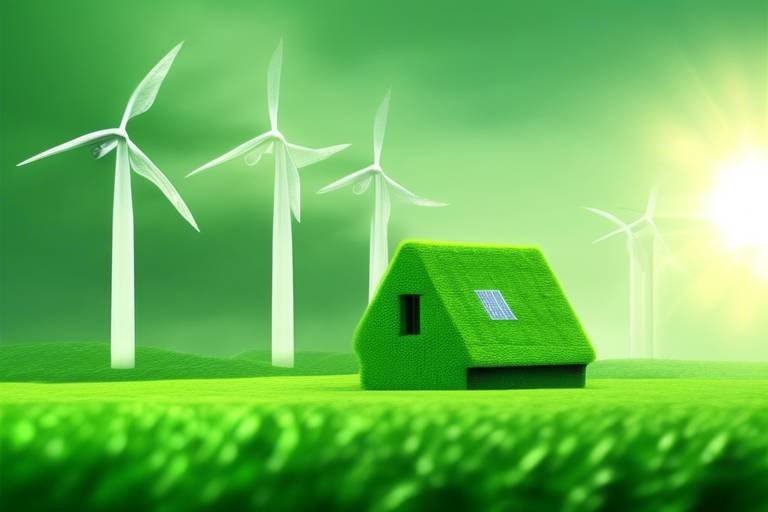Creating Green Office Spaces with Sustainable Energy Solutions
In today’s fast-paced world, where corporate responsibility is more than just a buzzword, creating green office spaces has become a necessity rather than a choice. Companies are increasingly realizing that sustainability not only benefits the planet but also enhances their bottom line. By adopting sustainable energy solutions, organizations can transform their work environments into eco-friendly havens that promote well-being and productivity. But what does it really mean to create a green office space? And how can businesses implement these sustainable practices effectively? Let’s dive into the world of sustainable energy and explore innovative strategies that can lead to a healthier workplace and a happier planet.
Sustainable energy refers to energy sources that are renewable and have minimal environmental impact. This includes solar, wind, hydroelectric, and geothermal energy, among others. These energy sources are crucial for office spaces because they reduce reliance on fossil fuels and decrease greenhouse gas emissions. Imagine harnessing the power of the sun to light up your office or using wind energy to power your computers. Not only does this reduce your carbon footprint, but it also positions your company as a leader in sustainability. In the following sections, we will discuss the various types of sustainable energy and their relevance to office environments, ensuring that you are well-informed about your options.
Adopting green office spaces can lead to numerous advantages, including reduced operational costs, improved employee well-being, and enhanced corporate image. The benefits are not just theoretical; they are backed by research and real-world examples. When companies invest in sustainable practices, they often find that the returns are substantial. Let’s break down some of these benefits in detail.
Implementing sustainable energy solutions can significantly lower energy bills. For instance, businesses that switch to energy-efficient lighting and appliances can see a dramatic drop in their electricity costs. According to studies, companies can save up to 30% on their energy bills by making simple changes. Additionally, renewable energy sources, such as solar panels, can provide long-term savings by reducing dependency on traditional power grids. Imagine the relief of watching your monthly expenses shrink while contributing to a healthier planet!
Investing in sustainable energy infrastructure is not only beneficial for the environment but also a smart long-term financial decision. While the initial costs may seem daunting, the long-term benefits far outweigh them. For example, businesses that invest in solar energy can expect a return on investment within 5 to 10 years, depending on various factors such as location and energy consumption. This means that after the initial investment, companies can enjoy free energy for decades! It's like planting a tree today that will provide shade and fruit for years to come.
Many governments offer incentives for businesses to adopt sustainable practices. These can include grants, tax breaks, and rebates that can significantly reduce the financial burden of transitioning to green energy. For example, in the United States, the federal government offers tax credits for solar energy installations, which can cover a substantial portion of the costs. By tapping into these resources, businesses can make sustainable choices without breaking the bank. It’s a win-win situation!
A green office environment can enhance employee morale and productivity. Studies have shown that employees who work in spaces with natural light, plants, and clean air tend to be more productive and satisfied with their jobs. In fact, companies that prioritize sustainability often report lower turnover rates and higher employee engagement. Imagine walking into an office filled with greenery and natural light; it’s not just a pleasant sight, but it also fosters creativity and collaboration among team members. The connection between sustainable practices and employee satisfaction is undeniable!
While transitioning to green office spaces offers many benefits, there are challenges to consider. It’s important to recognize these obstacles and develop strategies to overcome them. In the following sections, we will address common challenges and provide potential solutions to help you navigate the path to sustainability.
The upfront investment for sustainable energy solutions can be a barrier for many businesses. However, financing options such as green loans and leasing programs can help mitigate these costs. Additionally, many companies find that the long-term savings on energy bills make the initial investment worthwhile. Think of it as buying a high-quality pair of shoes; while they may cost more upfront, they last longer and provide better comfort than cheaper alternatives.
Identifying trustworthy suppliers for sustainable materials and technologies is crucial. With so many options available, it can be overwhelming to choose the right partners in the green energy sector. When selecting suppliers, consider their reputation, certifications, and customer reviews. Building strong relationships with reliable vendors will ensure that your transition to sustainable practices is smooth and successful.
1. What are the most common types of sustainable energy?
The most common types of sustainable energy include solar, wind, hydroelectric, and geothermal energy. Each of these sources has unique benefits and applications for office spaces.
2. How can I start transitioning to a green office?
Begin by assessing your current energy consumption and identifying areas for improvement. Consider investing in energy-efficient appliances, renewable energy sources, and sustainable materials.
3. Are there financial incentives for going green?
Yes, many governments offer grants, tax credits, and rebates to businesses that adopt sustainable practices. Research local programs to find out what’s available in your area.
4. Will a green office really improve employee productivity?
Absolutely! Studies have shown that green office environments enhance employee morale, creativity, and overall productivity.

Understanding Sustainable Energy
Sustainable energy is a term that encompasses energy sources that are not only renewable but also have a minimal impact on our environment. Imagine a world where the energy we use doesn’t deplete natural resources or harm our planet. That’s the beauty of sustainable energy! It includes sources like solar, wind, hydro, and geothermal energy, each contributing to a cleaner and greener future.
Let’s break it down a bit. Solar energy harnesses the power of the sun through solar panels, converting sunlight into electricity. It’s like capturing sunlight in a bottle! Then there's wind energy, which uses wind turbines to generate power. Just picture those giant windmills turning gracefully in the breeze, creating energy without emitting harmful gases. Hydropower, on the other hand, utilizes the flow of water, typically from rivers or dams, to produce electricity. Think of it as nature's way of powering our homes and offices. Finally, geothermal energy taps into the Earth’s internal heat, providing a stable and reliable energy source.
These energy sources are crucial for office spaces looking to reduce their carbon footprint. By integrating sustainable energy solutions, businesses can not only lower their energy costs but also contribute to a healthier planet. The relevance of sustainable energy in office environments is becoming increasingly clear. Companies are recognizing that their energy choices can significantly impact not just their bottom line but also their reputation and employee satisfaction.
Furthermore, the implementation of sustainable energy solutions can lead to a more resilient energy system. For instance, when offices invest in solar panels, they become less reliant on the traditional energy grid, which can be subject to fluctuations and outages. This independence means that businesses can operate more smoothly, even during energy crises. In a way, it’s like having a backup generator that runs on sunshine!
In conclusion, understanding sustainable energy is the first step towards creating a green office space. By embracing renewable energy sources, companies can pave the way for a sustainable future, benefiting not just themselves but the entire planet. It’s time to think of energy not just as a utility, but as a vital part of our commitment to a healthier, more sustainable world.

Benefits of Green Office Spaces
Embracing green office spaces is not just a trend; it's a transformative journey that can yield remarkable benefits for businesses, employees, and the environment alike. Imagine walking into an office that not only looks good but feels good too. A space filled with natural light, fresh air, and greenery can significantly enhance the overall atmosphere, making it a welcoming place for employees and clients. But the perks don't stop there! Let's dive into some of the most compelling advantages of adopting sustainable practices in the workplace.
One of the most immediate benefits of green office spaces is the potential for cost savings. By implementing energy-efficient systems and utilizing renewable energy sources, businesses can drastically reduce their operational costs. For instance, companies that invest in solar panels can see their energy bills plummet, allowing them to allocate those savings toward other critical areas of the business. In fact, studies have shown that businesses can save up to 30% on energy costs by switching to sustainable energy practices. Isn't that an enticing prospect?
Moreover, green office spaces contribute to employee productivity and well-being. Numerous studies have indicated a direct correlation between a sustainable work environment and employee satisfaction. When employees are surrounded by eco-friendly designs, natural elements, and better air quality, they tend to feel more motivated and engaged. A green office can also reduce stress levels and promote a sense of community among employees. After all, who wouldn’t want to work in a place that prioritizes their health and happiness?
Another significant benefit is the enhancement of a company's corporate image. In today's eco-conscious world, consumers and clients are increasingly favoring businesses that demonstrate a commitment to sustainability. By adopting green practices, companies can position themselves as leaders in corporate responsibility, attracting more clients and enhancing their brand reputation. This shift not only helps in customer retention but also opens doors to new business opportunities. Think of it as a badge of honor that showcases your dedication to the planet!
In addition to these benefits, green office spaces can also lead to improved employee retention. When employees feel valued and see that their employer is making efforts to create a healthier work environment, they are more likely to stay with the company long-term. This not only reduces turnover costs but also fosters a loyal and dedicated workforce. It’s a win-win situation that every business should consider.
To summarize, the benefits of green office spaces are profound and multi-faceted. From cost savings and enhanced employee well-being to a better corporate image and improved retention rates, the advantages are clear. Transitioning to a sustainable work environment is not just an ethical choice; it’s a strategic business decision that can lead to long-term success. So, why wait? Embrace the green revolution and watch your business thrive!

Cost Savings
Implementing sustainable energy solutions in office spaces is like finding a hidden treasure chest; the initial effort may seem daunting, but the rewards are plentiful. One of the most compelling reasons to transition to a green office is the significant that can be achieved. Think about it: energy-efficient systems and renewable energy sources not only help the environment but also shrink those pesky energy bills. By harnessing the power of the sun through solar panels or optimizing heating and cooling systems, businesses can reduce their operational costs substantially.
To put it into perspective, consider the following statistics:
| Energy Source | Average Cost Savings |
|---|---|
| Solar Energy | Up to 30% on electricity bills |
| Energy-Efficient Lighting | About 75% less energy consumption |
| Smart Thermostats | 10-20% savings on heating and cooling |
As you can see, the numbers speak for themselves! The initial investment in these technologies might seem high, but the long-term savings can easily justify the upfront costs. In fact, many companies report a return on investment (ROI) within just a few years of implementing these solutions. Imagine redirecting those savings into other areas of your business—like employee training, new technology, or even fun team-building activities!
Moreover, adopting sustainable practices can lead to lower maintenance costs. Energy-efficient appliances and systems tend to have longer lifespans and require less frequent repairs. So not only do you save on energy bills, but you also save on the costs associated with maintaining outdated, less efficient equipment.
Another aspect to consider is the potential for increased productivity, which can indirectly lead to cost savings. Employees who work in a healthy, eco-friendly environment tend to be more engaged and productive. This boost in morale can translate to higher output and efficiency, further enhancing your bottom line.
In conclusion, while the path to a green office may require some initial financial commitment, the long-term cost savings are undeniable. By investing in sustainable energy solutions, businesses can not only contribute to a healthier planet but also enjoy significant financial benefits that can propel their success.

Long-term Investments
Investing in sustainable energy infrastructure is not merely a trend; it's a strategic decision that pays off in the long run. Think of it as planting a seed today to reap the benefits tomorrow. When businesses transition to green office spaces, they are not just doing their part for the planet; they are also making a smart financial move that can lead to significant returns over time.
One of the primary advantages of these long-term investments is the reduction in energy costs. By implementing energy-efficient solutions, companies can drastically decrease their reliance on traditional energy sources, which often come with fluctuating prices. For instance, businesses that invest in solar panels can harness the power of the sun, effectively turning their rooftops into energy-generating assets. Over the years, the savings on utility bills can accumulate to a substantial amount, allowing companies to redirect those funds towards growth and innovation.
Moreover, sustainable energy solutions often come with increased property value. According to recent studies, buildings that incorporate green technologies are not only more attractive to potential tenants but also tend to sell for higher prices. This increase in property value can be a game-changer for businesses looking to expand or relocate in the future.
In addition to energy savings and property value appreciation, there are also tax incentives and grants available for businesses that invest in sustainable practices. Many governments recognize the importance of green initiatives and offer financial support to encourage companies to make the switch. This can significantly offset the initial costs associated with implementing sustainable energy solutions. For example, businesses can take advantage of tax credits for installing solar energy systems, which can lead to substantial savings on their tax bills.
While the initial investment may seem daunting, it's essential to view it as a long-term strategy. Just like investing in education or technology, investing in sustainable energy is about preparing for the future. The long-term benefits often far outweigh the upfront costs, making it a wise choice for any forward-thinking business. In the end, the question isn't whether to invest in sustainable energy solutions, but rather, can you afford not to?
- What are the most common sustainable energy solutions for offices? Solar panels, wind turbines, and energy-efficient lighting systems are among the most popular options.
- How long does it take to see a return on investment from sustainable energy solutions? Typically, businesses can expect to see a return on their investment within 5 to 10 years, depending on the energy solution implemented.
- Are there specific certifications for green office spaces? Yes, certifications like LEED (Leadership in Energy and Environmental Design) can help validate your green initiatives.
- Can small businesses benefit from sustainable energy investments? Absolutely! Many small businesses can take advantage of government incentives and grants that make these investments more accessible.

Government Incentives
When it comes to adopting sustainable practices in the workplace, government incentives can be the wind beneath your wings. These incentives are designed to encourage businesses to invest in green technologies and practices that not only benefit the environment but also enhance economic growth. Various forms of support are available, such as grants, tax breaks, and low-interest loans, which can significantly offset the initial costs of transitioning to green energy solutions.
For instance, many governments offer grants specifically aimed at helping companies implement renewable energy systems like solar panels or wind turbines. These funds can cover a substantial portion of the installation costs, making it easier for businesses to take that leap towards sustainability. Additionally, tax incentives can reduce the overall tax burden for companies that invest in energy-efficient technologies. This means that not only are businesses saving on energy bills, but they are also benefiting from reduced taxes, effectively doubling their financial gains.
Moreover, some regions have introduced accelerated depreciation programs that allow businesses to write off the costs of energy-efficient equipment much faster than traditional assets. This can lead to significant tax savings in the early years of investment. To give you a clearer picture, here’s a table summarizing some common government incentives:
| Type of Incentive | Description | Potential Benefits |
|---|---|---|
| Grants | Direct funds to support renewable energy projects. | Offset installation costs significantly. |
| Tax Breaks | Reductions in tax liabilities for green investments. | Lower operational costs and increased cash flow. |
| Low-Interest Loans | Loans with reduced interest rates for energy projects. | Affordable financing options for large projects. |
| Accelerated Depreciation | Faster write-offs for energy-efficient equipment. | Immediate tax savings in the early years. |
It's essential for businesses to stay informed about the specific incentives available in their region, as these can vary significantly from one place to another. Many local governments also have programs tailored to support small and medium-sized enterprises (SMEs), recognizing that these businesses play a crucial role in achieving sustainability goals. By taking the time to research and apply for these incentives, companies can not only enhance their sustainability efforts but also improve their bottom line.
In conclusion, government incentives serve as a powerful catalyst for businesses looking to embrace sustainable energy solutions. They not only provide financial relief but also create a culture of sustainability that can lead to long-term benefits. So, if you’re considering making your office greener, don’t forget to check what incentives are available. It might just be the nudge you need to start your journey towards a more sustainable future.
- What types of government incentives are available for sustainable energy projects?
Incentives can include grants, tax breaks, low-interest loans, and accelerated depreciation programs.
- How can I find out what incentives are available in my area?
Check with your local government’s website or consult with a sustainability consultant to explore available programs.
- Are government incentives only for large businesses?
No, many incentives are designed specifically for small and medium-sized enterprises as well.
- Can these incentives significantly reduce the cost of going green?
Absolutely! Many businesses find that these incentives cover a substantial portion of their initial investment.

Employee Productivity and Well-being
Creating a green office environment is not just about saving the planet; it’s also about enhancing the well-being and productivity of the people who work there. Imagine walking into an office filled with natural light, plants, and fresh air—sounds inviting, right? Studies have shown that a sustainable workspace can significantly boost employee morale and output. When employees feel good in their environment, they are more likely to be engaged, motivated, and productive. But how does this actually happen?
First off, let’s talk about air quality. Offices that incorporate plants and proper ventilation systems tend to have better air quality, which can lead to fewer sick days and higher energy levels. Employees are less likely to experience headaches, fatigue, or respiratory issues when they are surrounded by greenery and fresh air. In fact, a study by the University of Exeter found that productivity can increase by up to 15% in environments enriched with plants. That’s a pretty compelling reason to add a few potted plants to your office!
Moreover, the use of natural lighting is another crucial factor. Offices that maximize natural light not only reduce energy consumption but also help employees feel more connected to the outside world. Natural light can improve mood and focus, leading to a more vibrant workplace. In contrast, harsh artificial lighting can cause eye strain and fatigue, leading to decreased productivity. So, why not let the sunshine in? It’s a win-win situation!
In addition to these physical elements, the psychological benefits of a green office cannot be overlooked. A sustainable workplace often fosters a sense of community and shared responsibility among employees. When team members are involved in eco-friendly initiatives—like recycling programs or energy-saving challenges—they tend to feel more connected to one another and to the company’s mission. This sense of belonging can lead to increased job satisfaction and loyalty.
To put it in perspective, let’s consider some key factors that contribute to employee productivity and well-being in a green office:
| Factor | Impact on Employees |
|---|---|
| Air Quality | Reduces sick days, increases energy levels |
| Natural Light | Improves mood and focus |
| Green Spaces | Enhances creativity and reduces stress |
| Community Engagement | Fosters teamwork and job satisfaction |
Lastly, let’s not forget about the long-term effects of a green office on employee retention. Companies that prioritize sustainability often attract talent who share similar values. Employees are increasingly looking for employers who care about the environment and are willing to take actionable steps towards sustainability. This alignment of values can lead to a more committed and passionate workforce.
In conclusion, the relationship between a green office and employee productivity and well-being is undeniable. By investing in sustainable practices and creating a healthier work environment, companies can reap the benefits of a more engaged, motivated, and satisfied workforce. So, why wait? Start transforming your office into a green haven today!
- What are the main benefits of a green office? A green office can lead to reduced operational costs, improved employee well-being, and a positive corporate image.
- How can I improve air quality in my office? Incorporating plants, ensuring good ventilation, and using air purifiers can significantly enhance air quality.
- Are there any financial incentives for going green? Yes, many governments offer grants, tax breaks, and other financial support for businesses that adopt sustainable practices.
- How does natural light affect productivity? Natural light can improve mood and focus, leading to increased productivity and job satisfaction.

Challenges in Implementing Sustainable Solutions
Transitioning to sustainable energy solutions in office spaces is not all sunshine and rainbows. There are significant challenges that businesses face when trying to go green. One of the most daunting obstacles is the initial cost of implementing these solutions. For many companies, the upfront investment required for solar panels, energy-efficient appliances, or green building materials can feel overwhelming. However, it's essential to view this as a long-term investment rather than a mere expense. In the grand scheme, the savings on energy bills and the potential for increased employee productivity can far outweigh these initial costs.
Moreover, navigating the sea of available options can be quite tricky. With so many different sustainable technologies and materials on the market, how do businesses determine which ones are right for them? This is where finding reliable suppliers becomes crucial. Not only do companies need to ensure that the products they choose are genuinely sustainable, but they also need to consider the reliability and credibility of the suppliers they partner with. A poor choice can lead to wasted resources and missed opportunities. Therefore, conducting thorough research and seeking recommendations can be invaluable.
Another challenge is the cultural shift that often accompanies the move toward sustainability. Employees may be resistant to change, especially if they perceive new practices as inconvenient or unnecessary. To tackle this, businesses should focus on education and engagement. By informing employees about the benefits of sustainable practices—not just for the company but for their health and well-being—organizations can foster a culture of sustainability. This might involve workshops, informational sessions, or even fun challenges that encourage staff to adopt greener habits.
Lastly, regulatory hurdles can sometimes stand in the way of implementing sustainable solutions. Different regions have varying rules and regulations regarding energy use, emissions, and building standards. Companies must stay informed about these regulations to ensure compliance, which can sometimes feel like navigating a labyrinth. A proactive approach, including consulting with legal experts or sustainability consultants, can help organizations stay ahead of the game.
In summary, while the path to creating a green office space is filled with challenges, these obstacles are not insurmountable. By understanding the potential barriers—such as initial costs, supplier reliability, cultural shifts, and regulatory issues—businesses can devise strategies to overcome them. The journey may be tough, but the rewards of a sustainable office environment are well worth the effort.
- What are the main challenges businesses face when implementing sustainable solutions?
The main challenges include initial costs, finding reliable suppliers, cultural shifts within the organization, and navigating regulatory hurdles. - How can businesses mitigate the initial costs of sustainable solutions?
Companies can explore financing options, government incentives, and implement solutions gradually to spread out costs over time. - Why is employee engagement important in creating a green office?
Engaging employees fosters a culture of sustainability and can lead to higher morale and productivity, making the transition smoother. - How can businesses find reliable suppliers for sustainable materials?
Conducting thorough research, seeking recommendations, and checking certifications can help in identifying trustworthy suppliers.

Initial Costs
When it comes to implementing sustainable energy solutions in office spaces, one of the most significant hurdles businesses face is the . It's like buying a high-quality pair of shoes; the upfront price might make you hesitate, but the comfort and durability they offer in the long run are worth every penny. Similarly, investing in green technologies can seem daunting due to the initial financial outlay. However, understanding how to navigate these costs can make the transition smoother and more feasible.
Many companies find themselves in a bind, unsure of how to finance these sustainable upgrades. The reality is that while the initial investment can be high, the long-term savings on energy bills and maintenance can offset these costs significantly. In fact, a well-planned energy-efficient office can lead to savings of up to 30% on energy bills over time. To help visualize this, consider the following table:
| Investment Type | Initial Cost | Annual Savings | Payback Period |
|---|---|---|---|
| Solar Panels | $15,000 | $1,500 | 10 years |
| Energy-efficient HVAC | $10,000 | $1,200 | 8.3 years |
| LED Lighting | $5,000 | $800 | 6.25 years |
As seen in the table, while the upfront costs may appear steep, the long-term savings make these investments worthwhile. However, businesses should also consider financing options available to them. Many financial institutions offer green loans specifically designed for companies looking to invest in sustainable technologies. These loans often come with favorable terms, making it easier for businesses to manage their cash flow while transitioning to greener practices.
Another strategy to mitigate initial costs is to start small. Instead of overhauling the entire office infrastructure at once, businesses can implement changes gradually. For instance, beginning with energy-efficient lighting or smart thermostats can provide immediate benefits without the need for a massive upfront investment. This phased approach allows companies to spread out costs while still making progress toward a green office environment.
Moreover, it's essential to keep an eye out for government incentives and grants that can significantly reduce the financial burden of transitioning to sustainable energy solutions. Many local and federal programs are designed to support businesses in their green initiatives, offering everything from tax credits to direct funding for specific projects. By leveraging these resources, companies can effectively lower their initial costs and make sustainable investments more manageable.
In conclusion, while the initial costs of implementing sustainable energy solutions can be a barrier, they should not deter businesses from pursuing eco-friendly office spaces. With thoughtful planning, financing options, and available incentives, transitioning to a green office can be a financially sound decision that pays off in the long run. Remember, the journey to sustainability is a marathon, not a sprint, and every step taken is a step towards a healthier planet and a more efficient workplace.
- What are the main benefits of investing in sustainable energy solutions? Investing in sustainable energy solutions can lead to significant cost savings, improved employee morale, and a positive corporate image.
- Are there financing options available for green initiatives? Yes, many financial institutions offer loans specifically for green projects, as well as various government grants and incentives.
- How can small businesses manage initial costs? Small businesses can start by implementing changes gradually, focusing on affordable upgrades like energy-efficient lighting before moving on to larger investments.

Finding Reliable Suppliers
When it comes to creating a green office space, one of the most crucial steps is sourcing materials and technologies from reliable suppliers. After all, the success of your sustainable initiatives hinges not only on the strategies you implement but also on the quality and integrity of the products you choose. So, how do you navigate the vast landscape of suppliers to find those who truly align with your green vision?
First and foremost, it’s essential to conduct thorough research. Start by compiling a list of potential suppliers in the sustainable energy sector. This can be accomplished through online searches, industry forums, and recommendations from peers who have already taken the plunge into green practices. Once you have a list, dig deeper into each company’s background. Look for suppliers who have a proven track record of delivering high-quality, sustainable products. Ask yourself questions such as: What are their certifications? Are they recognized by reputable environmental organizations? Do they have positive customer reviews?
Moreover, consider the following factors when evaluating potential suppliers:
- Transparency: Reliable suppliers should be open about their sourcing methods, production processes, and environmental impact. A supplier who is willing to share this information demonstrates a commitment to sustainability.
- Certifications: Look for certifications like LEED, Energy Star, or other eco-labels that indicate compliance with sustainability standards. These certifications can serve as a mark of quality and reliability.
- Customer Support: A supplier that offers excellent customer service can make your transition to green practices much smoother. Ensure they provide support and guidance throughout the procurement process.
Another effective strategy is to attend industry trade shows and expos focused on sustainability. These events provide a fantastic opportunity to meet suppliers face-to-face, ask questions, and see their products in action. Networking at these events can also lead to valuable insights and recommendations from fellow businesses that have successfully implemented sustainable practices.
Lastly, don’t forget to establish a clear communication channel with your chosen suppliers. Regular check-ins can help you stay updated on new products, technologies, and best practices in the sustainable energy space. Building a strong relationship with your suppliers can also lead to better pricing, priority access to new innovations, and collaborative opportunities for future projects.
In summary, finding reliable suppliers for your green office space is a journey that requires careful consideration and proactive engagement. By prioritizing transparency, certifications, and strong communication, you can ensure that your sustainable initiatives are supported by trustworthy partners who share your commitment to a greener future.
Q1: How can I verify if a supplier is genuinely sustainable?
A1: Look for third-party certifications, customer reviews, and case studies that demonstrate their commitment to sustainability. Engaging in direct conversations with the supplier can also provide insights into their practices.
Q2: What should I do if I encounter issues with a supplier?
A2: Address the issue directly with the supplier first. If the problem persists, consider seeking alternative suppliers who can better meet your needs.
Q3: Are there any specific platforms to find sustainable suppliers?
A3: Yes, platforms like Eco-Business, GreenBiz, and various industry-specific directories can help you connect with suppliers specializing in sustainable products and services.
Frequently Asked Questions
- What is sustainable energy?
Sustainable energy refers to energy that is generated from renewable sources, such as solar, wind, and hydroelectric power. These sources are environmentally friendly and have a minimal impact on the planet, making them ideal for eco-conscious office spaces.
- How can green office spaces benefit my business?
Adopting green office spaces can lead to significant benefits, including reduced operational costs, improved employee well-being, and a stronger corporate image. By implementing sustainable practices, businesses can save money on energy bills, boost employee morale, and attract eco-minded clients.
- What are some common sustainable energy solutions for offices?
Some popular sustainable energy solutions for offices include solar panels, energy-efficient lighting, smart thermostats, and green building materials. These solutions not only reduce energy consumption but also contribute to a healthier work environment.
- Are there financial incentives for going green?
Yes! Many governments offer incentives such as grants, tax breaks, and rebates for businesses that adopt sustainable practices. These financial supports can help offset the initial costs of implementing green solutions.
- What are the challenges of implementing sustainable energy solutions?
While there are many benefits, challenges include the initial investment costs, finding reliable suppliers, and ensuring employee buy-in. However, with proper planning and research, these challenges can be effectively managed.
- How can I finance the initial costs of sustainable solutions?
Financing options may include loans specifically for green projects, leasing equipment, or partnering with investors who are interested in sustainability. Additionally, taking advantage of government incentives can significantly reduce out-of-pocket expenses.
- How do I choose reliable suppliers for sustainable materials?
To find trustworthy suppliers, research their credentials, check reviews, and ask for recommendations from other businesses. It’s also beneficial to inquire about their sustainability practices and certifications to ensure they align with your green goals.
- Can a green office space really improve employee productivity?
Absolutely! Studies show that a well-designed green office can enhance employee morale and productivity. Natural light, improved air quality, and a connection to nature all contribute to a more enjoyable and motivating work environment.

